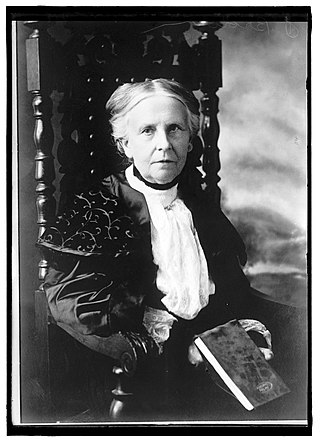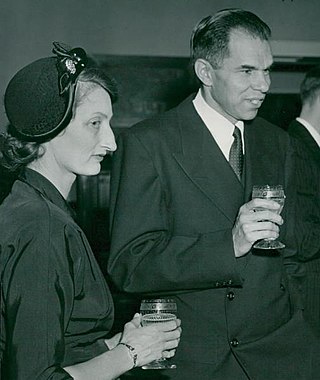
The Nineteenth Amendment to the United States Constitution prohibits the United States and its states from denying the right to vote to citizens of the United States on the basis of sex, in effect recognizing the right of women to vote. The amendment was the culmination of a decades-long movement for women's suffrage in the United States, at both the state and national levels, and was part of the worldwide movement towards women's suffrage and part of the wider women's rights movement. The first women's suffrage amendment was introduced in Congress in 1878. However, a suffrage amendment did not pass the House of Representatives until May 21, 1919, which was quickly followed by the Senate, on June 4, 1919. It was then submitted to the states for ratification, achieving the requisite 36 ratifications to secure adoption, and thereby go into effect, on August 18, 1920. The Nineteenth Amendment's adoption was certified on August 26, 1920.
Muller v. Oregon, 208 U.S. 412 (1908), was a landmark decision by the United States Supreme Court. Women were provided by state mandate lesser work-hours than allotted to men. The posed question was whether women's liberty to negotiate a contract with an employer should be equal to a man's. The law did not recognize sex-based discrimination in 1908; it was unrecognized until the case of Reed v. Reed in 1971; here, the test was not under the equal protections clause, but a test based on the general police powers of the state to protect the welfare of women when it infringed on her fundamental right to negotiate contracts; inequality was not a deciding factor because the sexes were inherently different in their particular conditions and had completely different functions; usage of labor laws that were made to nurture women's welfare and for the "benefit of all" people was decided to be not a violation of the Constitution's Contract Clause.

Olympia Brown was an American minister and suffragist. She was the first woman to be ordained as clergy with the consent of her denomination. Brown was also an articulate advocate for women's rights and one of the few first generation suffragists who were able to vote with the passage of the Nineteenth Amendment.

The League of Women Voters (LWV) is a nonprofit, nonpartisan political organization in the United States. Founded in 1920, its ongoing major activities include registering voters, providing voter information, and advocating for voting rights. In addition, the LWV works with partners that share its positions and supports a variety of progressive public policy positions, including campaign finance reform, women's rights, health care reform, gun control and LGBT+ rights.
Welfare reform is the process of proposing and adopting changes to a welfare system in order to improve the efficiency and administration of government assistance programs with the goal of enhancing equity and fairness for both welfare recipients and taxpayers. Reform programs have various aims: empowering individuals to help them become self-sufficient, ensuring the sustainability and solvency of various welfare programs, and/or promoting equitable distribution of resources. Welfare reform is constantly debated because of the varying opinions on a government's need to balance the imperatives of guaranteeing welfare benefits and promoting self-sufficiency.

Alice Stokes Paul was an American Quaker, suffragist, feminist, and women's rights activist, and one of the foremost leaders and strategists of the campaign for the Nineteenth Amendment to the U.S. Constitution, which prohibits sex discrimination in the right to vote. Paul initiated, and along with Lucy Burns and others, strategized events such as the Woman Suffrage Procession and the Silent Sentinels, which were part of the successful campaign that resulted in the amendment's passage in August 1920.

Julia Clifford Lathrop was an American social reformer in the area of education, social policy, and children's welfare. As director of the United States Children's Bureau from 1912 to 1922, she was the first woman ever to head a United States federal bureau.

The Personal Responsibility and Work Opportunity Reconciliation Act of 1996 (PRWORA) is a United States federal law passed by the 104th United States Congress and signed into law by President Bill Clinton. The bill implemented major changes to U.S. social welfare policy, replacing the Aid to Families with Dependent Children (AFDC) program with the Temporary Assistance for Needy Families (TANF) program.

Women's suffrage, or the right to vote, was established in the United States over the course of more than half a century, first in various states and localities, sometimes on a limited basis, and then nationally in 1920 with the ratification of the 19th Amendment to the United States Constitution.

Katherine Philips Edson was an American reformer and social activist who had a key role in changing the labor conditions in California and across the nation.

Harriot Eaton Blatch was an American writer and suffragist. She was the daughter of pioneering women's rights activist Elizabeth Cady Stanton.

Helen L. Seaborg was an American child welfare advocate and the wife of Nobel Prize chemist Glenn T. Seaborg.

The Woman Suffrage Procession on March 3, 1913, was the first suffragist parade in Washington, D.C. It was also the first large, organized march on Washington for political purposes. The procession was organized by the suffragists Alice Paul and Lucy Burns for the National American Woman Suffrage Association (NAWSA). Planning for the event began in Washington in December 1912. As stated in its official program, the parade's purpose was to "march in a spirit of protest against the present political organization of society, from which women are excluded."
Helen Ewing Nelson was a consumer protection advocate in the United States. She drafted the Consumer Bill of Rights and served in consumer advocacy positions for various government offices and other organizations.

Mary Colton, was an Australian philanthropist and suffragist.

Hazel Hunkins Hallinan was an American women's rights activist, journalist, and suffragist.

Elizabeth Greer Coit was a prominent Ohio suffragist and humanitarian, who founded Columbus' first women's suffrage organization and was its inaugural President.
Mae Caine was a 20th-century American suffragist and women's rights activist, civic leader, and government official in Nevada. President of the Suffrage Society in Elko County, she was also a vice president of the Nevada Equal Franchise Society, and a delegate from Nevada to the 45th convention of the National American Woman Suffrage Association in Washington, D.C.














